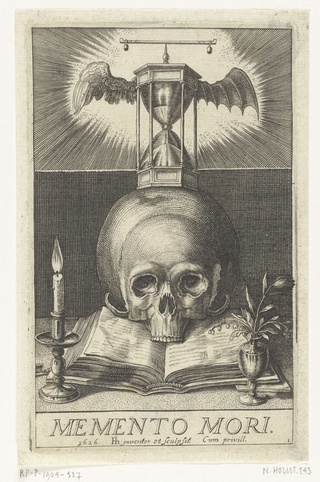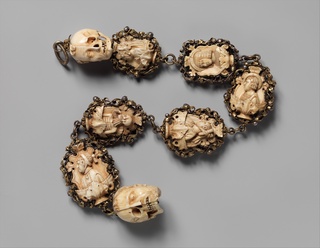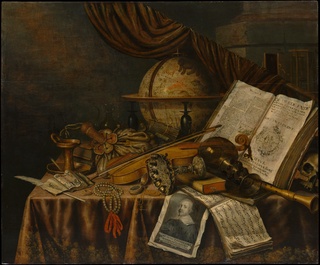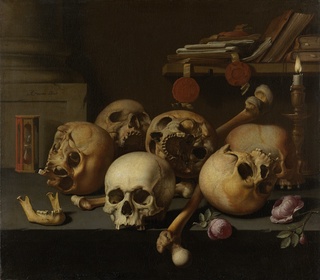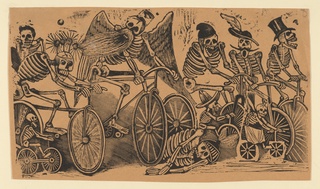Memento Mori: The Importance of Death for a Virtuous Life
By Blake Palmer•July 2022•9 Minute Read

Edwaert Collier, Vanitas Still Life, 1662. Metropolitan Museum of Art. Edwaert Collier's vanitas depicted real world luxuries of 17th-century European elites.
Memento mori is an age-old practice of meditating on death. Artworks with symbolic imagery often address the transience of life. Different cultures develop memento mori philosophies and art objects to inform their values for living.
Introduction
Thinking about death might be an uncomfortable prospect for many people, but what if it could help you live a better life? Thinkers and artists throughout world history, including ancient Greek philosophers, Tibetan Buddhist monks, and early Jewish religious writers, have all used memento mori to reflect on the values that shaped their lives.
History of Memento Mori
Translated from Latin, memento mori means, “Remember that you must die.” The concept was important to the Stoic philosophers of ancient Greece and Rome. They believed that ruminating on their mortality would ground their perspective through life’s ups and downs. The Stoic philosopher Epictetus claimed that slaves would whisper “memento mori” into the ears of triumphant generals as a humbling reminder.1 Caesar Marcus Aurelius, himself a Stoic student, would meditate on death to drive himself towards meaningful action, saying, “Let each thing you would do, say, or intend be like that of a dying person.”2
William Shakespeare made the first English literary reference to memento mori in 1598.3 In Henry IV, the character Falstaff says, “No, I’ll be sworn; I make as good use of it as many a man doth of a death’s-head or a memento mori.”4 Given that Shakespeare was writing hundreds of years after the Stoics, what had changed in the practice of contemplating death? How might the playwright’s audience have expected Falstaff to make “good use” of a memento mori?
By Shakespeare’s time, memento mori had started to evolve alongside Christianity in Europe. It became common practice to use visual symbols, like a death’s head, to remind oneself of the inevitable end of life and the importance of salvation. Lockets, pendants, and even rosaries helped keep death at the forefront of living.
All is Vanitas
Memento mori symbols started to appear in European portrait paintings as early as the 1400s. They became a prominent theme by the 17th century.5 Symbols representing death, dying, and the passage of time were used to remind the good Christian that life is fleeting, and so they should focus on attaining eternal rewards rather than the finite pleasures of life.
Vanitas still life paintings, which started in Holland and spread throughout Europe, became one of the most prominent examples of this practice in the West. The word “vanitas” was taken from a line in Ecclesiastes, an early Hebrew religious text that confronts the limitations of human ambition and wisdom.6 Ecclesiastes 1:2 reads, “Vanity of vanities, saith the Preacher, vanity of vanities, all is vanity.”7 These still lifes use a variety of memento mori to focus the viewer's mind on virtues that help one prepare for the afterlife, like bravery, spiritual focus, and decisive action.
Memento Mori Symbols
Death’s Head
A skull, or death’s head, is one of the most potent reminders that death is a universal experience. Philosophies around the world link the death’s head to the belief that confronting the reality of death lets us act without fear of it.
In Europe, skulls were a common reminder of the need to face death with courage. This same idea was expressed differently in other cultural contexts. Tecumseh, a renowned Shawnee orator, warrior, and chief, wrote a poem that encouraged people to meet their end bravely. He said, “When your time comes to die, be not like those whose hearts are filled with fear of death, so that when their time comes they weep and pray for a little more time to live their lives over again in a different way. Sing your death song, and die like a hero going home.”8
Time and Decay
Memento mori scenes often include objects that draw attention to the passing of time and the inexorable decay of all things. Clocks, burnt candles, rotting fruit, and wilted flowers are all classic vanitas symbols that can cause us to reflect on life’s transience and encourage us to seize the moment.
The idea of using one’s limited time wisely is a major theme in Christian texts. They are a significant source of the symbolism found in vanitas paintings. For instance, this Biblical imagery from 1 Peter 1:24 emphasizes that everyone passes from their glory to their end: “For, ‘all people are like grass, and all their glory is like the flowers of the field; the grass withers and the flowers fall.’”9
Wealth and Pleasure
Death is often seen as the great equalizer in a world filled with inequality. The rich, the poor, the powerful, and the oppressed are all marching towards the same fate. Artworks with memento mori often display signs of wealth and comfort, like coins, pearls, and wine, next to skeletal remains. This juxtaposition reminds the viewer that worldly treasures have no value beyond the grave. Instead of the fleeting pleasures that come with monetary gain, they are encouraged to focus on moral and spiritual values that offer eternal rewards to faithful Christians.
The same Jewish religious text that lent us the word vanitas echoes this belief. Ecclesiastes 7:2 reads, "It is better to go to a house of mourning than to go to a house of feasting, for death is the destiny of everyone; the living should take this to heart."10
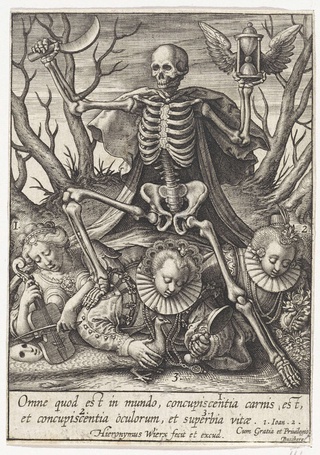
Celebrating Death
Reflecting on death doesn’t need to be a somber affair. Take Dia de los Muertos, or Day of the Dead. This Mexican celebration shares much of the imagery used in memento mori art and rituals throughout the world, including skulls, skeletons, and flowers. However, instead of focusing on the morbid aspects of life’s conclusion, celebrants approach the reality of death playfully. The holiday is used as an opportunity to savor life, friends, and family, and to honor loved ones who have passed on.
At many Day of the Dead celebrations, food and marigolds are laid out for the spirits of the departed, while the living dance together dressed as skeletons. People commune with ancestors at family altars, confronted with reminders that they, too, will perish. In the practice of calaveras literarias (literary skeleton), friends and family recite playful epitaphs to each other, speaking as if they had already passed on.11
Joyous festivals like this can take the sting out of death. In many ways, Dia de los Muertos is about appreciating life, the people we share it with, and the ancestors and kin who gave it to us.
Remembering Death and Rebirth
For traditions that see death as part of a cycle of rebirth rather than a final destination, practicing memento mori can offer different insights. Instead of focusing on how we can best use our limited time on Earth, a belief in karma and reincarnation makes it possible to think about how our actions might affect our future beyond this lifetime.
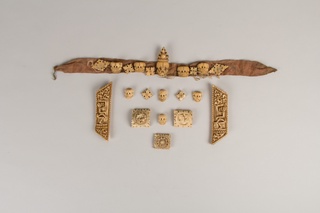
In Tibetan Buddhist tradition, the Chitipati are a pair of skeletal guardians whose name translates to Lords of the Funeral Mound. They were once ascetics who were beheaded by thieves as they meditated in a graveyard. In their new incarnation, the former ascetics became protection deities who dance and play music together in graveyards, only stopping to pursue retribution against thieves who pass through. Their story shows not only how their mindful meditation led to karmic rewards in the next life, but how harmful actions often bring consequences that reverberate beyond death.
A pair of dancing Chitipati are a common motif in Tibetan Buddhist art. Twice a year, monks hold rituals in which they blow horns and dance in colorful skeleton costumes, recreating scenes of the Chitipati that are helpful reminders of the ongoing cycle of death, rebirth, and karma that affects all beings in the Buddhist cosmology.12
Memento Mori in a Changing World
Memento mori is an ancient idea, but the contemplation of death still plays an important part in art and philosophy today. The ways that humans live with our mortality and the lessons we learn from it have evolved to suit the needs of our cultures and environments.
Our world is changing quickly. What might memento mori look like as we face intensifying global catastrophes like climate change and mass extinction events? How could a practice of acknowledging death help us develop individual and shared values that address the ways in which our lives and deaths are increasingly interconnected?
No matter what the future holds, we know that it will hold death. How we choose to confront our current reality will have consequences that echo far beyond our own lifetimes and permeate constructed boundaries like nation, class, and species. As we work together to co-create the world of the future, death still has a lot to teach us.
Blake Palmer is a scholar, writer, and cultural critic based in Chiang Mai, Thailand, working on popular culture, sustainability, traditional Thai foodways, and Asian contemporary art. His interests are drawn towards the intersection of culture, power, and art as a vector of sociopolitical critique. Blake’s current academic research focuses on multispecies biopolitics in the Southeast Asian context.
Citations
Epictetus, et al. Discourses of Epictetus 3.24, Arkose Press, 2015.
Aurelius, Marcus. Meditations 2.11.1, SDE Classics, 2019.
Brewer, Charlotte. “Shakespeare, Word-Coining and the OED.” Shakespeare Survey: A Midsummer Night's Dream, Peter Holland, ed., vol. 65, Cambridge University Press, Cambridge, 2012, pp. 353, https://oed.hertford.ox.ac.uk/wp-content/uploads/2019/07/Brewer_2012.pdf. Accessed 6 May 2022.
Shakespeare, William, et al. Henry IV, Part 1, 3.3.29–30, Folger Shakespeare Library, Annotated, Simon and Schuster, 2020.
Pound, Cath. “These Lush 17th-Century Paintings Were Striking Reminders of Mortality.” Artsy, 28 October 2019, www.artsy.net/article/artsy-editorial-lush-17th-century-paintings-striking-reminders-mortality. Accessed 6 May 2022.
“Vanitas.” Wikipedia, en.wikipedia.org/wiki/Vanitas. Accessed 6 May 2022.
King James Version. Biblica, 2011. BibleGateway.com, https://www.biblegateway.com/passage/?search=ecclesiastes+1%3A2&version=KJV. Accessed 6 May 2022.
Sultzman, Lee. “Shawnee History.” Tolatsga, www.tolatsga.org/shaw.html. Accessed 6 May 2022.
New International Version. Biblica, 2011. BibleGateway.com, https://www.biblegateway.com/passage/?search=1+Peter+1%3A24&version=NIV. Accessed 6 May 2022.
New International Version. BibleGateway.com, https://www.biblegateway.com/passage/?search=Ecclesiastes+7%3A2&version=NIV. Accessed 6 May 2022.
“Day of the Dead.” Wikipedia, en.wikipedia.org/wiki/Dayofthe_Dead. Accessed 6 May 2022.
“Citipati (Buddhism).” Wikipedia, en.wikipedia.org/wiki/Citipati_(Buddhism). Accessed 6 May 2022.
Blake Palmer is a scholar, writer, and cultural critic based in Chiang Mai, Thailand, working on popular culture, sustainability, traditional Thai foodways, and Asian contemporary art. His interests are drawn towards the intersection of culture, power, and art as a vector of sociopolitical critique. Blake’s current academic research focuses on multispecies biopolitics in the Southeast Asian context.
